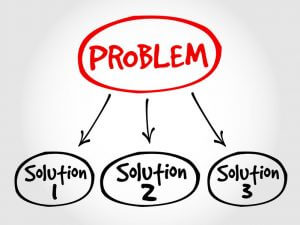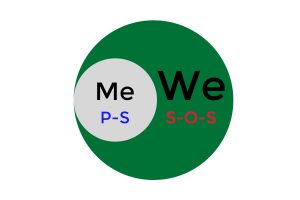
The default method for solving problems, Problem-Solving, contains a fatal flaw sending consultants and their clients down the wrong path. To increase business performance, problem-solving needs to be removed from leadership and consulting toolkits.
An extreme statement? Perhaps, but the reason is simple.
Define Problem-Solving
First, let’s ensure we agree how problem-solving works and avoid dictionary misalignment. In the most basic terms, you describe a problem, for example, “X is broken”, respond with a list of potential solutions to fix X, then use a process for deciding which solution or combination of solutions to act on.
Unfortunately, this approach is invalid when the problem to be solved is one shared by two or more people – which covers just about every time a business leader, manager, or consultant needs to problem-solve.

Individually Rational
Each potential solution suggested by a group member is logical and rational, at least to the person submitting it. Their fellow problem-solvers may agree. However, like-mindedness does not equal correctness.
Or there is disagreement about the suggestions being made:
The group must now converge on a solution they can all endorse. Perhaps the consultant nudges them towards ‘the right answer.’
There may be a feeling of success, but just as with the situation where they naturally agreed with the suggested solution, resolving their disagreement and reaching consensus only means alignment around what to do, not that the solution is the correct.
Which, too often, it isn’t.
Flawed Solutions
Let’s take the following management consulting example:
Problem: We are 13th in the market.
Potential Solutions:
Again, all logical and rational actions which might solve the problem.
The consultant may have inspired the client team into further-out-of-the-box thinking and offered additonal options to consider:
The group can now apply sorting, grouping, and ranking to come up with the best way to move up and out of 13th place.
(Some will say this is wrong, and the correct solution is to conduct root-cause analysis and find the source of the problem, then problem-solve that. But this is no better; just a delaying tactic. Root cause analysis may more accurately define the problem, say, that management is not willing to invest sufficiently in R&D and marketing, but when they apply problem-solving to that problem – coming up with a list of potential actions to stop management under-investing – they run into the same flaw.)

Problem-Solving’s Business Flaw
Our research showed that when the team was told the problem that they are 13th in the marketplace and requested to solve the problem, they each had a view (with varying degrees of clarity and conviction) of where those actions should take them:
Do you see the flaw? The group was not solutioning how to attain the same future state. Their means were aimed at different ends.

Where Problem-Solving Works
Problem-solving is only appropriate when used by one person for one person’s needs. Let’s take this example:
Problem: I am hungry.
Potential Solutions:
It is my problem, to which I can, alone, find a solution that works best for me. Unlike business problems,
In such situations, my brain develops and evaluates my multiple, competing objectives such as:
in a nano-second.
This led me to buy the two doughnuts now and promise to cook grilled chicken and boiled kale for dinner to compensate.
You might make a wiser choice, but that is OK, this was just about me.

Solving Problems Involving Two or More People
Problem-solving’s lack of a shared outcome towards which to solution is a problem because SchellingPoint’s analysis of over 330 organizational initiatives showed that groups are never fully aligned on target outcomes. On average, a business team with a shared situation will express 18 desired outcomes but only agree on 5.
A ‘good’ problem-solving facilitator may bring a group’s list of solutions to a consensus path forward, or a leader may step in and dictate the path forward, but both approaches leave silent resistance and compliance, compromising genuine commitment to the solution.
Therefore, replace two-step problem-solving with three-step situation-outcome-solution (S-O-S):
Describe the current or projected situation, and the negative consequence of not responding to it. When all persons agree with these two aspects of the situation, conduct step 2.
Define the required outcome by flipping the negative situation 180 degrees into a positive outcome. For example:
Convergence on the required outcome may occur naturally. When it does not, ask for the the objectives driving people’s preferences. When those are listed and ranked, you select the right outcome(s) for the group, and their organization with whose strategy the outcome(s) should be vertically aligned.
When all persons endorse the required outcome(s), conduct step 3.
At this point, with the context of a target outcome defined, the solutions offered are more specific and relevant rather than a litany of rational ideas with varying value to the outcome. Also, a positive side-effect is that our brain works well thinking how to flee problems but performs better ideating how to create positive futures.
Practitioner’s report that groups naturally align far more often and faster with less need for facilitation.
When does S-O-S not work?
This Situation – Outcomes – Solution (S-O-S) method works for topics large and small. It has been successfully applied to thousands of problems, from large situations, such as “We have a broken merger” to relatively small situations, such as “Staff joining the R&D team are taking too long to come up to speed.”
However, S-O-S is not as simple as Problem-Solving. You have to define the required Outcome(s) and confirm each group member agrees with them. People who find one minute to be 59 seconds too long and prefer to ‘get straight to it’, don’t want to take the time to get it right, seeing better future outcomes as a vague, intangible concept.
If my argument hasn’t convinced you of the personal and client ROI, try it on the next three problems you are involved in solving. Think of yourself not as a problem-solver but as an outcomes-generator.
Out of Scope
You can use S-O-S solo to solve personal problems such as deciding between a groaning stomach, a doughnut or a kale smoothie. Especially next time you suspect you are about to make a poor choice. However, you are on your own; we only take support calls for business uses ;-).
I would enjoy hearing about your experiences replacing P-S with S-O-S. Please send examples to mtaylor@schellingpoint.com for possible inclusion in an update to this post. Or send me situation statement and outcome proposals you want vetting. (Hint: New practitioners’ most frequent error is including action verbs in the outcome statements.)
To learn more about this method and others in the Strategic Collaboration Core Skills curriculum, see here.